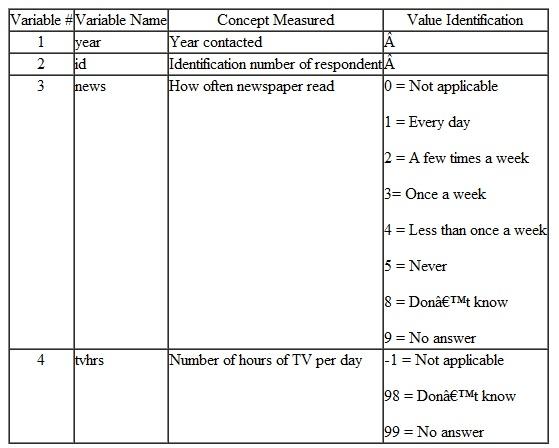
A Visual Approach to SPSS for Windows 2nd Edition by Leonard Stern
Edition 2ISBN: 978-0205706051
A Visual Approach to SPSS for Windows 2nd Edition by Leonard Stern
Edition 2ISBN: 978-0205706051 Exercise 3
The data in the file GSS92.sav are from randomly selected adults aged 18-65 contacted by the National Opinion Research Center from 1993-1998. The data include two variables used in this chapter's exercises-- news and tvhrs. The variable news is the response to the question "How often do you read the newspaper-every day, a few times a week, once a week, less than once a week, or never " The variable tvhrs is the response to the question "On the average day, how many hours do you personally watch television " The table below describes the variables and their values in the data file.
 1. Make up a new variable called seqnum that is the case number of each person in the survey.
1. Make up a new variable called seqnum that is the case number of each person in the survey.
2. Make up a new variable called nocontact that has the value 1 if a person both watches 1 or fewer hours of TV per day and never reads a newspaper, and has the value 0 otherwise.
3. Select the cases for which the variable nocontact has the value 1. Check your data file to see if the first three cases in which nocontact has the value 1 are case numbers 279, 293, and 347.
 1. Make up a new variable called seqnum that is the case number of each person in the survey.
1. Make up a new variable called seqnum that is the case number of each person in the survey.2. Make up a new variable called nocontact that has the value 1 if a person both watches 1 or fewer hours of TV per day and never reads a newspaper, and has the value 0 otherwise.
3. Select the cases for which the variable nocontact has the value 1. Check your data file to see if the first three cases in which nocontact has the value 1 are case numbers 279, 293, and 347.
Explanation
1)
Using SPSS, make a new variable Seqnu...
A Visual Approach to SPSS for Windows 2nd Edition by Leonard Stern
Why don’t you like this exercise?
Other Minimum 8 character and maximum 255 character
Character 255



